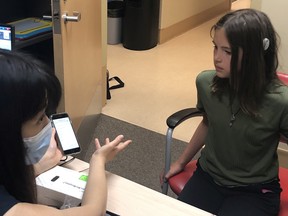Milestone surgery will improve the lives of children with hearing loss.

.
When 10-year-old Lila McKeague ate lunch at a busy French restaurant in Vancouver on Wednesday, it wasn’t the pommes frites that excited her the most. It was the clang in the kitchen, the rattle of cutlery, the clink of glassware on the bar, and the rhythm of chatter in the background.
.
For the first time since her birth, the sixth grader from Cranbrook could hear everything.
“There was a shocked look in his eyes,” dad Tim McKeague said.
Shortly before lunch, Lila had a new hearing aid fitted at BC Children’s Hospital. Osia’s bone conduction device was implanted just below his left ear in June and on Wednesday morning was connected via a magnet to a small external transducer. Lila will now be able to capture much more in the spectrum of complex soundscapes.
The classroom, music, movies, and group conversations will be much more manageable and, perhaps more importantly for the young woman, more fun.
“It was very difficult to hear people before, especially in my classroom,” said Lila, who was born with microtia and ear canal atresia (lack of an ear canal) on the left side. The congenital anomaly creates a “conductive” hearing loss, which means that sound is not conducted correctly through the ear. And because the outer part of the ear is not fully developed, she could not use a conventional hearing aid or hearing aids.
Lilia underwent outpatient surgery at BC Children’s in June to implant a bone conduction device under the skin behind her left ear. On Wednesday, audiologists at the hospital fitted the external transducer that attaches to her head with a magnet. She no longer has to wear a tight, uncomfortable band around her head to keep her old hearing aid in place.
The Osia also has a microphone that others can use to talk directly and a Bluetooth component so users can stream sound directly to the implant from any compatible digital device.
.
“Everything is much louder and feels comfortable,” Lila said.
When the opportunity arose to become one of the first children in BC to receive the implant, McKeague said Lila was “very excited” and didn’t hesitate.
“I was excited, I was really excited but nervous putting it on for the first time, about how it would feel, but I can barely feel anything,” Lila said.
Alison Beers, provincial coordinator for BC’s early hearing program, said the devices, which are the size of a Toonie, are more comfortable for children with microtia who can’t wear conventional hearing aids.
The operation for the implant involves a small incision just behind the ear and the implant is attached to the skull with a small screw. Once the incision heals, the external device is placed and the magnet is adjusted to be strong enough to stay in place.
“You should be able to do all of your activities with the device in place,” Beers said.
The hospital has completed two Osia implants this year and hopes to complete at least 10 more before the end of the year, in what Beers called a “milestone” after two years of preparation.
For the McKeague family, the event is life changing.
“To sit there having lunch with her and to see her eyes widen, to hear everything, it was phenomenal,” said Tim McKeague.